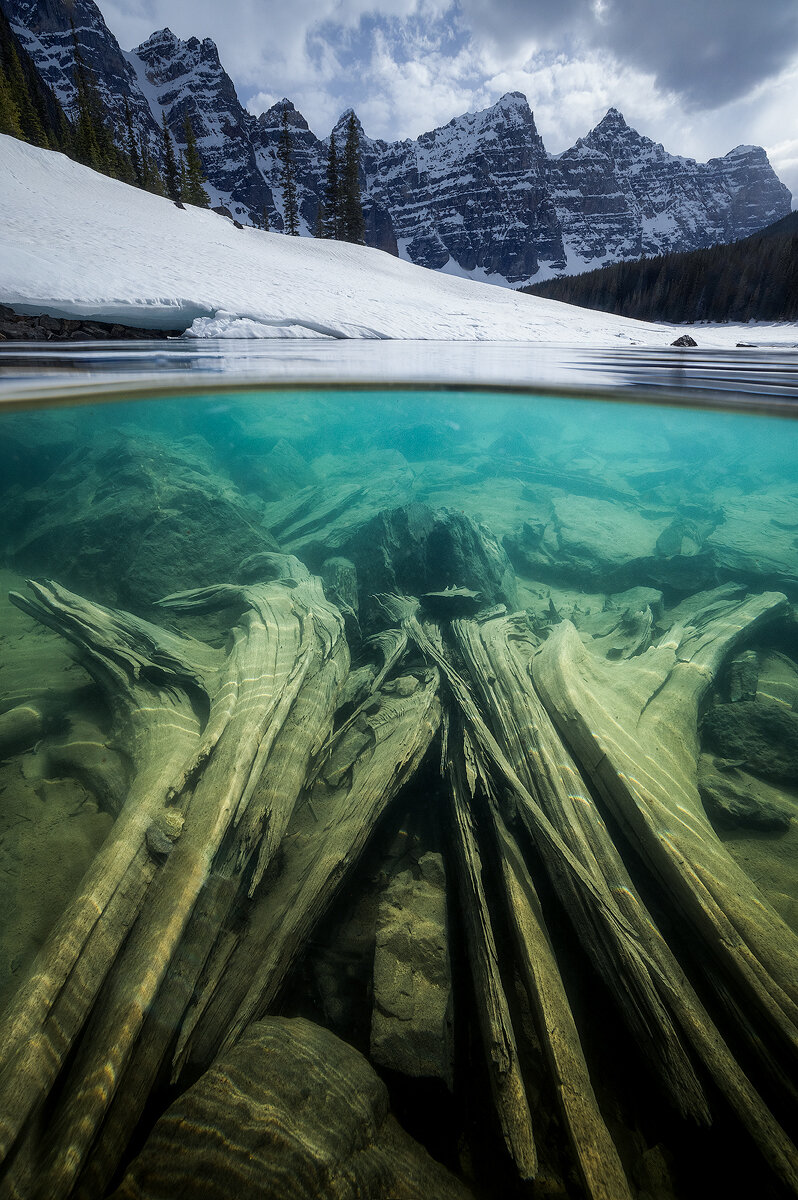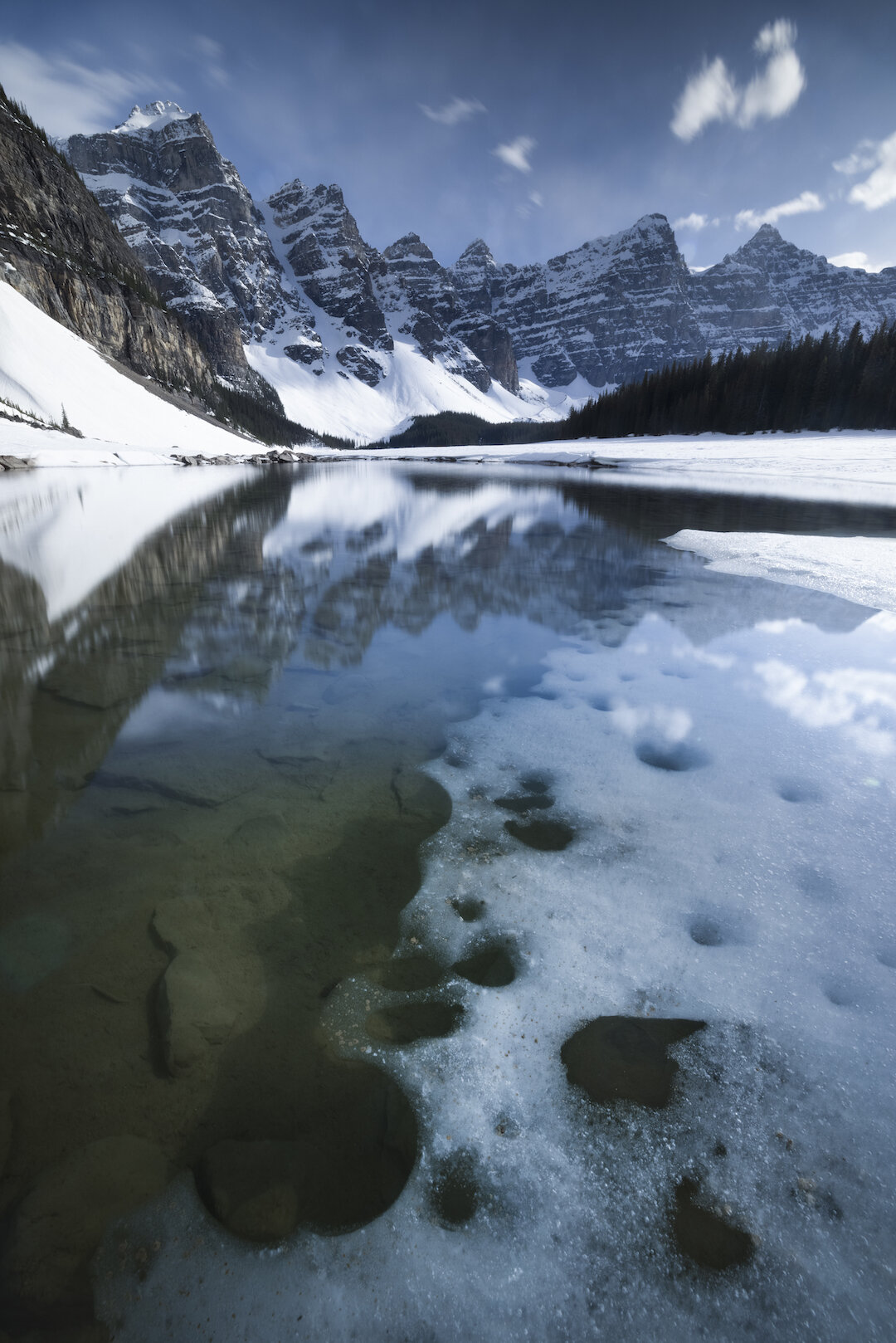Moraine Lake Between Seasons: A Multi-Sport Photography Adventure
Most people know Moraine Lake for its turquoise waters, mountainous skyline, and bustling shoreline but the passing seasons paint entirely different scenes. Come winter, snow blankets the frozen lake and its lonely shores but it is rarely seen or photographed this way because of winter road closures.
Equipped with AquaTech underwater housing for the Canon R5 and aware that Moraine Lake would soon be teeming with visitors, I set out to capture a tranquil moment between seasons. I envisioned a shot that simultaneously showed two worlds, the one above the surface and the one below—but getting this shot would take a 22-kilometre self-powered and multi-sport journey timed perfectly without much information about the conditions. It sounded like an ideal adventure for our team at Paul Zizka Photography.
Paul Zizka Photography team member Trixie arrives at Moraine Lake on skis. Photo by Paul Zizka.
Biking the 11-kilometre road to Moraine Lake with skis, poles, ice axe, and camera gear in tow. Photo by Trixie Pacis.
Ready For Anything
I rode off towards Moraine Lake from Wilson Mountain Sports in Lake Louise Village with Meghan and Trixie. We each had skis and poles strapped to our backpacks. Mine was fully loaded with waders, gumboots, underwater housing, camera gear, an ice axe, Honeystingers, and a can of coconut water. I’d heard that plowing had begun on the road into Moraine but had no idea whether we’d be biking for one kilometre or eleven. Climbing the hill to the Moraine Lake turnoff, I hoped I would need all the gear I was carrying.
Moraine Lake is nestled in the Valley of the Ten Peaks at an elevation of 1,885 metres (6,183 feet). The road from Lake Louise Village winds gradually upward for 11 kilometres. The combination of the elevation gain and dynamic time of year meant we could expect a variety of conditions along the way. We navigated patches of ice and slush as we pedalled on and, as luck would have it, the road had been plowed up to the 8-kilometre mark. We stashed our bikes in the forest, swapped to light touring skis, and glided quickly through a section beneath an avalanche path, into a postcard view of the majestic Ten Peaks. The last kilometre or so was a quick descent to Moraine Lake with our fingers crossed for some open water.
Searching for foreground with brand new AquaTech underwater housing for the Canon R5. Photo by Trixie Pacis.
Finding Foreground
We didn’t know what to expect at the lake. Following a stretch of warm weather, I was hoping to find a hole in the ice large enough to submerge my camera into but packed an ice axe just in case. We skied up to the lake and I was thrilled to see open water glistening in the sun. I wouldn’t need the ice axe after all!
I ditched my skis, changed into waders and gumboots, and secured my camera inside brand new Aquatech underwater housing designed for the R5. Having tested the housing in the bathtub before the trip, I was confident it would keep my camera dry.
I wanted to compose a shot with something interesting in the foreground. I waded in, careful not to kick up too much mud or silt as I searched for interesting features beneath the surface. I found colourful rocks, rippled sand, dancing light, and the edge of the ice shelf. I also collected a red solo cup, tattered visor, and golf ball. In the end, what stood out to me most was a submerged tree.
Getting the Shot
After hours without stopping, it was finally time to snap the image. I half-submerged the camera and housing in order to capture the sunken log and the landscape above the surface in a single frame.
One trick I’ve learned for over/underwater photography is to submerge the dome entirely, lift it halfway, line up the shot, then click within the first few seconds (before water streaks on the dome). Here are the images I came away with.
Settings for the first image in the series.
With the mission accomplished, I took bonus photos of Meghan and Trixie from the iconic rock pile and soaked in the view. It’s rare to share Moraine Lake with only two other people. At around 4 pm, we clicked into our skis and trudged back to where we stashed our bikes. The plow had made progress since we last saw it, which meant that it wouldn’t be long before the usual crowds were back. We hopped back on bikes and enjoyed a downhill ride into the sunset.
There’s a lot that goes into the making of an image like this. Taking the shot only took five minutes while the round-trip took nine hours all in. That said, I always encourage putting the experience before the image. Going in, I knew that whether or not I got the image I was after, it would be a great team adventure.
Standing before a reflection of the Ten Peaks in Moraine Lake with AquaTech underwater housing in hand. Photo by Trixie Pacis.
The Gear
Images like these wouldn’t be possible without the right gear. I rely on underwater housing from my partner AquaTech for all of my underwater photography. I used AquaTech Edge Sport Housing for the Canon EOS R5 and was super impressed with the level of clarity it provided. Facing challenging conditions where the water is chilly and the light changes quickly, I was also glad to have reliable gear that made my job easier.
This adventure was also supported by bike and ski equipment from the fantastic team at Wilson Mountain Sports.









